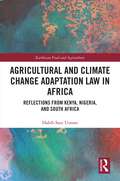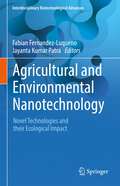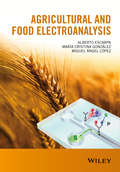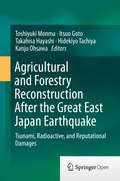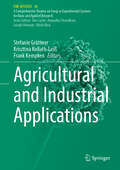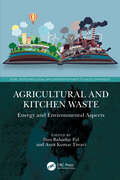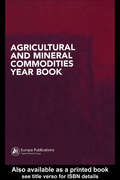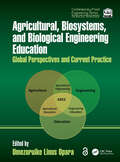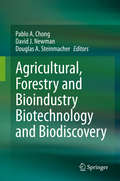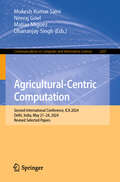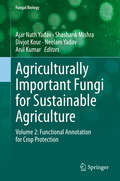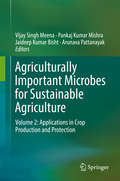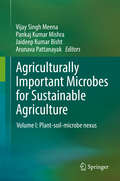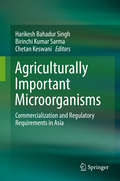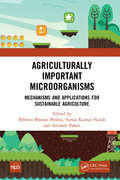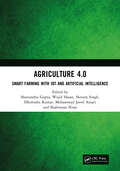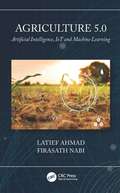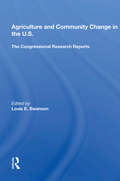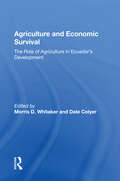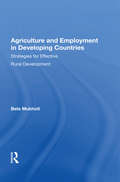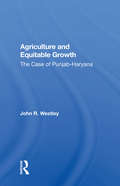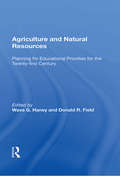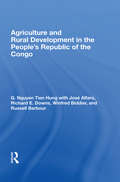- Table View
- List View
Agricultural and Climate Change Adaptation Law in Africa: Reflections from Kenya, Nigeria, and South Africa (Earthscan Food and Agriculture)
by Habib Sani UsmanThis book presents an analysis of climate change and agricultural laws in Kenya, Nigeria, and South Africa in order to determine whether they adequately addressed the concept of agricultural adaptation.Agriculture is one of the sectors of the economy that is contributing to climate change, and at the same time the sector is heavily impacted by climate change. Therefore agricultural adaptation is required. Focusing on three countries, this book provides a novel, comparative examination of how and to what extent the law promotes agriculture-focused adaptation in these countries. The role of the law in addressing issues such as water management strategies, soil conservation methods, and crop production methods is discussed. This book identifies gaps in the regulatory frameworks for agricultural adaptation and highlights the lack of adaptive capacity of African agriculture due to weak or non-existing legal frameworks. It discusses ways to remedy these gaps through specific on-farm adaptation strategies, legislative amendments to consolidate all relevant national climate change-related policies and laws with agricultural policies and laws that have relevant provisions on adaptation as medium-term solutions, and the development of a specific framework law for agriculture-focused adaptation, incorporating essential agricultural adaptation strategies, could perhaps be enacted as long-term solutions to the regulatory gaps.This book will be of great interest to students and scholars of law, climate change, food and agriculture, sustainable development, and African studies.
Agricultural and Environmental Nanotechnology: Novel Technologies and their Ecological Impact (Interdisciplinary Biotechnological Advances)
by Jayanta Kumar Patra Fabian Fernandez-LuquenoThis book highlights the best practices regarding nanoscience and nanotechnology for agriculture and environmental sectors to shape sustainable development thought to improve the quality and quantity of the agriculture products and to decrease the collateral effect of nanotechnology in the ecosystems. Besides, leading nanotechnologies are showed and discussed to guarantee their proper management in lands and ecosystems. Therefore, nanotechnologies such as agronanobiotechnology, nanofertilization, pest control, magnetofection for plant breeding, plant molecular farming, OMICs technologies, phytonanotechnology, nanoremediation, etc. are described in five sections and 21 chapters. Undoubtedly it is an ideal and updated book for undergraduate or postgraduate students, and scientists or researchers involved in nanoscience, nanotechnology, crop production, and remediation technologies as well as for those researchers that solving technical problems regarding the crop management and the human and environmental health without hampering the pursuit of sustainable development goals.
Agricultural and Environmental Sustainability: Considerations for the Future
by Manjit S. KangUnderstand sustainable development from economic, ecological, and social perspectivesAs world population continues to increase, the need grows for a safe, sustainable supply of food. Agricultural and Environmental Sustainability: Considerations for the Future provides the latest research results and vital information on the process of p
Agricultural and Food Electroanalysis
by Alberto Escarpa María Cristina González Miguel Ángel LópezAgricultural and Food Electroanalysis offers a comprehensive rationale of electroanalysis, revealing its enormous potential in agricultural food analysis. A unique approach is used which fills a gap in the literature by bringing in applications to everyday problems. This timely text presents in-depth descriptions about different electrochemical techniques following their basic principles, instrumentation and main applications. Such techniques offer invaluable features such as inherent miniaturization, high sensitivity and selectivity, low cost, independence of sample turbidity, high compatibility with modern technologies such as microchips and biosensors, and the use of exciting nanomaterials such as nanoparticles, nanotubes and nanowires. Due to the advantages that modern electroanalytical techniques bring to food analysis, and the huge importance and emphasis given today to food quality and safety, this comprehensive work will be an essential read for professionals and researchers working in analytical laboratories and development departments, and a valuable guide for students studying for careers in food science, technology and chemistry.
Agricultural and Forestry Reconstruction After the Great East Japan Earthquake: Tsunami, Radioactive, and Reputational Damages
by Toshiyuki Monma Itsuo Goto Takahisa Hayashi Hidekiyo Tachiya Kanju OhsawaThis book summarizes the results of 3 years of agricultural and forestry reconstructive efforts and applied research conducted directly in the affected areas of Fukushima following the Great East Japan Earthquake. It describes fast and effective revival methods and technologies from tsunami and radiation damages, demonstrated through the collaborative efforts of researchers, students, local farmers, forest owners, and municipalities gathered under the Tokyo University of Agriculture East Japan Assistance Project. Consisting of four parts, the first part of the book provides an overview of the damage and measures taken to overcome them by the local municipalities and the Tokyo University of Agriculture. The second part presents data and results of agricultural recovery from the tsunami--for example, monitoring systems, reconstruction models, and convenient, low-cost methods developed for the restoration of tsunami-damaged paddy fields. The third part focuses on recovery from radiation-contaminated farmlands and forests and consequent reputational damages. Included are various primary data obtained from field experiments and surveys, studies on the mechanism of contamination, and the results of radical monitoring, decontamination, and restoration techniques performed at this site. The final part is a collection of reflections of local farmers, forest owners, and students who participated in the project. The academic trials and errors recorded in this book are an invaluable contribution to disaster management and recovery processes. It is written for a wide audience, not limited to researchers and students, but also for government and state officials, municipalities, agricultural cooperative staff members, and farmers.
Agricultural and Industrial Applications (The Mycota #16)
by Frank Kempken Stefanie Grüttner Krisztina Kollath-LeißThis volume provides an overview of the current state of the art in agricultural and industrial mycology. It highlights the importance and potential of fungi in these fields. Several topics relate to the critical and ambiguous role of fungi in agriculture, including beneficial and pathogenic fungal-plant interactions and food spoilage caused by mycotoxins. In addition, this volume provides a fascinating insight into ergot alkaloids. The impact of climate change on the occurrence of pathogenic fungi is also discussed. Fungi play an important role in a wide range of industrial processes, including the fermentation of food and beverages and the biotechnological production of metabolites and enzymes. A number of specific applications are discussed in this volume, such as the production of vitamins and enzymes from marine fungi. In addition to mycologists working in industry, agriculture and academia, the book will be of interest to students of biotechnology, microbiology and mycology. Chapter 3 is available open access under a Creative Commons Attribution 4.0 International License via link.springer.com.
Agricultural and Kitchen Waste: Energy and Environmental Aspects (Novel Biotechnological Applications for Waste to Value Conversion)
by Dan Bahadur Pal Amit Kumar TiwariApart from being termed as a pollution source, agriculture and kitchen waste is also a rich source of carbohydrates, minerals, antioxidants and vitamins, and can be utilized to develop value-added products and for energy production, which is the main theme of this book. It also focuses on the minimization of this waste via different routes like conversion into bio-fertilizers, organic acids, other industrial products, and efficient energy production. It comprises different topics and concepts related to waste utilization contributed by recognized researchers and experts. Features: Covers all the technical aspects of utilization of agricultural and kitchen waste. Discusses the quality characteristics of value-added products. Provides overview of different options for processing of organic wastes. Includes production of acids and enzymes from agriculture/kitchen wastes. Reviews effects of kitchen/agricultural waste on environment and its role in pollution control. This book is aimed at researchers and graduate students in chemical and environmental engineering.
Agricultural and Mineral Commodities Year Book
by Europa PublicationsAn in-depth survey of the major commodities of the world* Profiles each commodity in detail* Provides in-depth statistics on production* Includes an invaluable directoryContents:* Introductory essays* Covers all major agricultural and mineral products including aluminium, coal, cotton, nickel, petroleum, bananas, rice, rubber, tea, coffee, tobacco, wheat, natural gas, soybeans, zinc, lead and phosphates* Each commodity is profiled in detail with information on physical appearance, history, uses, major markets, trends in demand, major importers and exporters* Statistical details of recent levels of production at a global and individual country level* Recent trends in prices with indexes of export prices* A directory of organizations concerned with commodities.
Agricultural, Biosystems, and Biological Engineering Education: Global Perspectives and Current Practice (Contemporary Food Engineering)
by Umezuruike Linus OparaAgricultural engineering, developed as an engineering discipline underpinned by physics, applies scientific principles, knowledge, and technological innovations in the agricultural and food industries. During the last century, there was exponential growth in engineering developments, which has improved human wellbeing and radically changed how humans interact with each other and our planet. Among these, “Agricultural Mechanization” is ranked among the top 10 in a list of 20 Top Engineering Achievements of the last century that have had the greatest impact on the quality of life.While many success stories abound, the problems of low appeal among students, identity crises, and limited job opportunities in many climes continue to trouble the discipline’s future in many parts of the world. Yet agriculture and agricultural engineering remain fundamental to assuring food and nutrition security for a growing global population.Agricultural, Biosystems, and Biological Engineering Education provides the first comprehensive global review and synthesis of different agricultural, biosystems, and biological engineering education approaches, including a detailed exposition of current practices from different regions.Key Features: Describes novel approaches to curriculum design and reform Outlines current and emerging epistemology and pedagogies in ABBE education Provides a framework to grow agricultural engineering in Africa and other developing regions Highlights the role of ABBE education in the context of the SDGs Presented in 3 parts and containing 42 chapters, this book covers the historical evolution of agricultural engineering education and discusses the emergence of biological and biosystems engineering education. It will appeal to engineers and other professionals, education planners and administrators, and policy makers in agriculture and other biological industries.Chapters 4, 11, 19, 32, and 41 of this book are freely available as a downloadable Open Access PDF at http://www.taylorfrancis.com under a Creative Commons Attribution-Non Commercial-No Derivatives (CC-BY-NC-ND) 4.0 license.
Agricultural, Forestry and Bioindustry Biotechnology and Biodiscovery
by David J. Newman Pablo A. Chong Douglas A. SteinmacherFood security, crop protection, biodiversity, and human and environmental health are among the main needs and concerns of society. Modern biotechnology and life sciences represent a constantly evolving area that is key for the rational use of natural resources – resources that in turn are indispensable for societal development. This book features the outcomes of the IV International Biotechnology and Biodiversity Congress, held in Guayaquil, Ecuador, 2018. It includes extensive reviews of the trends in agricultural and forestry biotechnology, molecules and materials biodiscovery, ethnomedicine, environmental impact and bioindustry research, describing many of these topics from the Latin America perspective and showing how the biodiversity and ancient knowledge of these countries are vital for worldwide sustainable development.
Agricultural-Centric Computation: Second International Conference, ICA 2024, Delhi, India, May 21–24, 2024, Revised Selected Papers (Communications in Computer and Information Science #2207)
by Dhananjay Singh Mukesh Kumar Saini Neeraj Goel Matias MiguezThis book constitutes the proceedings of the Second International Conference on Agricultural-Centric Computation, ICA 2024, held in Delhi, India, during May 21–24, 2024. The 20 full papers and 6 short papers included in this book were carefully reviewed and selected from 79 submissions. This year's conference focuses on how advanced computational techniques can address critical issues in the agricultural sector, such as climate resilience, food security, sustainable practices, biodiversity conservation, soil health, water management, and market access.
Agriculturally Important Fungi for Sustainable Agriculture: Volume 1: Perspective for Diversity and Crop Productivity (Fungal Biology)
by Anil Kumar Ajar Nath Yadav Shashank Mishra Neelam Yadav Divjot KourMicrobes are ubiquitous in nature. Among microbes, fungal communities play an important role in agriculture, the environment, and medicine. Vast fungal diversity has been associated with plant systems, namely epiphytic fungi, endophytic fungi, and rhizospheric fungi. These fungi associated with plant systems play an important role in plant growth, crop yield, and soil health. Rhizospheric fungi, present in rhizospheric zones, get their nutrients from root exudates released by plant root systems, which help with their growth, development, and microbe activity. Endophytic fungi typically enter plant hosts through naturally occurring wounds that are the result of plant growth, through root hairs, or at epidermal conjunctions. Phyllospheric fungi may survive or proliferate on leaves depending on material influences in leaf diffuseness or exudates.The diverse nature of these fungal communities is a key component of soil-plant systems, where they are engaged in a network of interactions endophytically, phyllospherically, as well as in the rhizosphere, and thus have emerged as a promising tool for sustainable agriculture. These fungal communities promote plant growth directly and indirectly by using plant growth promoting (PGP) attributes. These PGP fungi can be used as biofertilizers and biocontrol agents in place of chemical fertilizers and pesticides for a more eco-friendly method of promoting sustainable agriculture and environments.This first volume of a two-volume set covers the biodiversity of plant-associated fungal communities and their role in plant growth promotion, the mitigation of abiotic stress, and soil fertility for sustainable agriculture. This book should be useful to those working in the biological sciences, especially for microbiologists, microbial biotechnologists, biochemists, and researchers and scientists of fungal biotechnology.
Agriculturally Important Fungi for Sustainable Agriculture: Volume 2: Functional Annotation for Crop Protection (Fungal Biology)
by Anil Kumar Ajar Nath Yadav Shashank Mishra Neelam Yadav Divjot KourMicrobes are ubiquitous in nature. Among microbes, fungal communities play an important role in agriculture, the environment, and medicine. Vast fungal diversity has been found in plant systems. The fungi associated with any plant system are in the form of epiphytic, endophytic, and rhizospheric fungi. These associated fungi play important roles in plant growth, crop yield, and soil health.The rhizospheric fungi present in rhizospheric zones have a sufficient amount of nutrients released by plant root systems in the form of root exudates for growth, development, and activities of microbes. Endophytic fungi enter in host plants mainly through wounds that naturally occur as a result of plant growth, or develop through root hairs and at epidermal conjunctions. The phyllospheric fungi may survive or proliferate on leaves, depending on the extent of influences of material in leaf diffuseness or exudates. The diverse group of fungal communities is a key component of soil-plant systems, where they are engaged in an intense network of interactions in the rhizospheric, endophytic, and phyllospheric areas, and they have emerged as an important and promising tool for sustainable agriculture. These fungal communities help to promote plant growth directly or indirectly by mechanisms for plant growth-promoting (PGP) attributes. These PGP fungi can be used as biofertilizers, bioinoculants, and biocontrol agents in place of chemical fertilizers and pesticides in an environmentally and eco-friendly manner. This book covers the current knowledge of plant-associated fungi and their potential biotechnological applications in agriculture and allied sectors. This book should be useful to scientists, researchers, and students of microbiology, biotechnology, agriculture, molecular biology, environmental biology, and related subjects.
Agriculturally Important Microbes for Sustainable Agriculture: Volume 2: Applications in Crop Production and Protection
by Jaideep Kumar Bisht Vijay Singh Meena Pankaj Kumar Mishra Arunava PattanayakThis book presents a compilation of case studies from different countries on achieving agricultural sustainability. The book stresses that, in order to meet the needs of our rapidly growing population, it is imperative to increase agricultural productivity. If global food production is to keep pace with an increasing population, while formulating new food production strategies for developing countries, the great challenge for modern societies is to boost agricultural productivity. Today, the application of chemicals to enhance plant growth or induced resistance in plants is limited due to the negative effects of chemical treatment and the difficulty of determining the optimal concentrations to benefit the plant. In the search for alternative means to solve these problems, biological applications have been extensively studied. Naturally occurring plant-microbe-environment interactions are utilized in many ways to enhance plant productivity. As such, a greater understanding of how plants and microbes coexist and benefit one another can yield new strategies to improve plant productivity in the most sustainable way. Developing sustainable agricultural practices requires understanding both the basic and applied aspects of agriculturally important microorganisms, with a focus on transforming agricultural systems from being nutrient-deficient to nutrient-rich. This work is divided into two volumes, the aim being to provide a comprehensive description and to highlight a holistic approach, respectively. Taken together, the two volumes address the fundamentals, applications, research trends and new prospects of agricultural sustainability. Volume one consists of two sections, with the first addressing the role of microbes in sustainability, and the second exploring beneficial soil microbe interaction in several economically important crops. Section I elucidates various mechanisms and beneficial natural processes that enhance soil fertility and create rhizospheric conditions favourable for high fertility and sustainable soil flora. It examines the mechanism of action and importance of rhizobacteria and mycorrhizal associations in soil. In turn, section II presents selected case studies involving economically important crops. This section explains how agriculturally beneficial microbes have been utilized in sustainable cultivation with high productivity. Sustainable food production without degrading the soil and environmental quality is a major priority throughout the world, making this book a timely addition. It offers a comprehensive collection of information that will benefit students and researchers working in the field of rhizospheric mechanisms, agricultural microbiology, biotechnology, agronomy and sustainable agriculture, as well as policymakers in the area of food security and sustainable agriculture.
Agriculturally Important Microbes for Sustainable Agriculture: Volume I: Plant-soil-microbe nexus
by Jaideep Kumar Bisht Vijay Singh Meena Pankaj Kumar Mishra Arunava PattanayakThis book presents a compilation of case studies from different countries on achieving agricultural sustainability. The book stresses that, in order to meet the needs of our rapidly growing population, it is imperative to increase agricultural productivity. If global food production is to keep pace with an increasing population, while formulating new food production strategies for developing countries, the great challenge for modern societies is to boost agricultural productivity. Today, the application of chemicals to enhance plant growth or induced resistance in plants is limited due to the negative effects of chemical treatment and the difficulty of determining the optimal concentrations to benefit the plant. In the search for alternative means to solve these problems, biological applications have been extensively studied. Naturally occurring plant-microbe-environment interactions are utilized in many ways to enhance plant productivity. As such, a greater understanding of how plants and microbes coexist and benefit one another can yield new strategies to improve plant productivity in the most sustainable way. Developing sustainable agricultural practices requires understanding both the basic and applied aspects of agriculturally important microorganisms, with a focus on transforming agricultural systems from being nutrient-deficient to nutrient-rich. This work is divided into two volumes, the aim being to provide a comprehensive description and to highlight a holistic approach, respectively. Taken together, the two volumes address the fundamentals, applications, research trends and new prospects of agricultural sustainability. Volume one consists of two sections, with the first addressing the role of microbes in sustainability, and the second exploring beneficial soil microbe interaction in several economically important crops. Section I elucidates various mechanisms and beneficial natural processes that enhance soil fertility and create rhizospheric conditions favourable for high fertility and sustainable soil flora. It examines the mechanism of action and importance of rhizobacteria and mycorrhizal associations in soil. In turn, section II presents selected case studies involving economically important crops. This section explains how agriculturally beneficial microbes have been utilized in sustainable cultivation with high productivity. Sustainable food production without degrading the soil and environmental quality is a major priority throughout the world, making this book a timely addition. It offers a comprehensive collection of information that will benefit students and researchers working in the field of rhizospheric mechanisms, agricultural microbiology, biotechnology, agronomy and sustainable agriculture, as well as policymakers in the area of food security and sustainable agriculture.
Agriculturally Important Microorganisms: Commercialization and Regulatory Requirements in Asia
by Harikesh Bahadur Singh Chetan Keswani Birinchi Kumar SarmaThe main focus of this book is to survey the current status of research, development and use of agriculturally important microorganisms in Asian countries and develop a strategy for addressing critical issues various policy constraints due to which bio-pesticides have found limited applications. In this book the editors have tried to develop a consensus on issues of such as quality requirements, quality control, regulatory management, commercialization and marketing of agriculturally important microorganisms in Asian countries. All these issues are discussed at national level by competent authorities of Asian countries including India, China, Malaysia, Iran, Taiwan, Israel, Sri Lanka, Vietnam and Philippines.
Agriculturally Important Microorganisms: Mechanisms and Applications for Sustainable Agriculture
by Bibhuti Bhusan Mishra Suraja Kumar Nayak Avishek PahariThe book encompasses different Agriculturally Important microorganisms (AIMs), mechanisms of action and modes of application for sustainable agriculture. The potential of microbes in nitrogen fixation, solubilizing nutrients like phosphorous, Potassium, tolerance to etc. are the major strength of the book. There is relatively a new frontier, use of Plant Growth Promoting Rhizobacteria(PGPR)in enhancing crop productivity. These microbes inhabit at the rhizospheric region of the root and facilitate plant growth through a variety of direct and indirect mechanisms. These PGP have been identified to solubilize phosphate, Potassium, Zinc, produce siderophore, IAA, Hydrogencyanide, fix ammonia and many more. Today, such microbes are extensively studied not only as a biofertilizer or fortification of nutrient to the plant, but also a potential agent to decrease application of chemical fertilizer and other agrochemicals. The book also gives an insight to this aspect also. Last but not the least,a light has been thrown on use and application of nano-biofertilizer for sustainable agriculture.Note: T&F does not sell or distribute the hardback in India, Pakistan, Nepal, Bhutan, Bangladesh and Sri Lanka. This title is co-published with NIPA.
Agriculture 4.0: Smart Farming with IoT and Artificial Intelligence
by Dhirendra Kumar Mohammad Javed Ansari Sheetanshu Gupta Wajid Hasan Shivom Singh Shabistana NisarWith the convergence of the Internet of Things (IoT) and Artificial Intelligence (AI), the traditional methods of farming are undergoing transformation. By harnessing the power of data-driven insights and automation, farmers can now make informed decisions in real time, optimize resource utilization, and mitigate risks associated with crop management and livestock welfare.This book serves as a guide to the integration of IoT and AI in agriculture and discusses the methodologies, applications, and challenges in this rapidly evolving field. It details various aspects of smart farming—from crop monitoring and precision agriculture to livestock management and food supply chain transparency—and provides insight into the potential of IoT and AI to revolutionize agricultural practices and address the global challenges of food security, environmental sustainability, and economic development.Print edition not for sale in South Asia (India, Sri Lanka, Nepal, Bangladesh, Pakistan or Bhutan)
Agriculture 5.0: Artificial Intelligence, IoT and Machine Learning
by Latief Ahmad Firasath NabiAgriculture 5.0: Artificial Intelligence, IoT & Machine Learning provides an interdisciplinary, integrative overview of latest development in the domain of smart farming. It shows how the traditional farming practices are being enhanced and modified by automation and introduction of modern scalable technological solutions that cut down on risks, enhance sustainability, and deliver predictive decisions to the grower, in order to make agriculture more productive. An elaborative approach has been used to highlight the applicability and adoption of key technologies and techniques such WSN, IoT, AI and ML in agronomic activities ranging from collection of information, analysing and drawing meaningful insights from the information which is more accurate, timely and reliable.It synthesizes interdisciplinary theory, concepts, definitions, models and findings involved in complex global sustainability problem-solving, making it an essential guide and reference. It includes real-world examples and applications making the book accessible to a broader interdisciplinary readership. This book clarifies hoe the birth of smart and intelligent agriculture is being nurtured and driven by the deployment of tiny sensors or AI/ML enabled UAV’s or low powered Internet of Things setups for the sensing, monitoring, collection, processing and storing of the information over the cloud platforms. This book is ideal for researchers, academics, post-graduate students and practitioners of agricultural universities, who want to embrace new agricultural technologies for Determination of site-specific crop requirements, future farming strategies related to controlling of chemical sprays, yield, price assessments with the help of AI/ML driven intelligent decision support systems and use of agri-robots for sowing and harvesting. The book will be covering and exploring the applications and some case studies of each technology, that have heavily made impact as grand successes. The main aim of the book is to give the readers immense insights into the impact and scope of WSN, IoT, AI and ML in the growth of intelligent digital farming and Agriculture revolution 5.0.The book also focuses on feasibility of precision farming and the problems faced during adoption of precision farming techniques, its potential in India and various policy measures taken all over the world. The reader can find a description of different decision support tools like crop simulation models, their types, and application in PA. Features: Detailed description of the latest tools and technologies available for the Agriculture 5.0. Elaborative information for different type of hardware, platforms and machine learning techniques for use in smart farming. Elucidates various types of predictive modeling techniques available for intelligent and accurate agricultural decision making from real time collected information for site specific precision farming. Information about different type of regulations and policies made by all over the world for the motivation farmers and innovators to invest and adopt the AI and ML enabled tools and farming systems for sustainable production.
Agriculture And Community Change In The U.s.: The Congressional Research Reports
by Louis E. SwansonThis book contains the Office of Technology Assessment commissioned papers analyzing the Northeast, South, Midwest, the Great Plains and the West of the U.S. The papers indicate that the relationship between the structure of agriculture and characteristics of rural communities vary in the U.S. .
Agriculture And Economic Survival: The Role Of Agriculture In Ecuador's Development
by Morris D WhitakerOriginally published in 1990, in this study the authors have surveyed and anaylsed a large volume of difficult to access or unpublished papers and literature and it organised it into thirteen chapters. Subjects covered include introductory and concluding essays, development policy, agricultural performance, natural resources, the labor market, production, irrigation, marketing and credit of Ecuador's agricultural sector.
Agriculture And Employment In Developing Countries: Strategies For Effective Rural Development
by Bela B MukhotiHigh rates of growth in agricultural production need not be incompatible with increased employment, income, and the satisfaction of basic needs in the lower-income developing countries. Emphasizing this theme, the author presents three alternative agricultural development strategies and suggests guidelines for identifying appropriate policies and p
Agriculture And Equitable Growth: The Case Of Punjab-haryana
by John R. WestleyThis book aims to examine how the pattern of growth in the agricultural sectors has contributed to equitable growth and to assess the relevance of the relationship between agriculture and equitable growth in Punjab-Haryana for other states in India and for other low-income countries.
Agriculture And Natural Resources: Planning For Educational Priorities For The Twenty-first Century
by Donald R. Field Wava G. HaneyThis book identifies issues and trends in agriculture, natural resources, and rural communities in the context of topical strategic planning. It portrays both the process of planning and the substantive content driving a planning process. .
Agriculture And Rural Development In The People's Republic Of The Congo
by G. Nguyen HungThis comprehensive study outlines the current transformation in agriculture and its effect on the demography, development, and economy of the People’s Republic of the Congo. G. Nguyen Tien Hung analyzes fundamental structural changes within the economy and the impact of the application of the Marxist model of development upon the performance and gr
